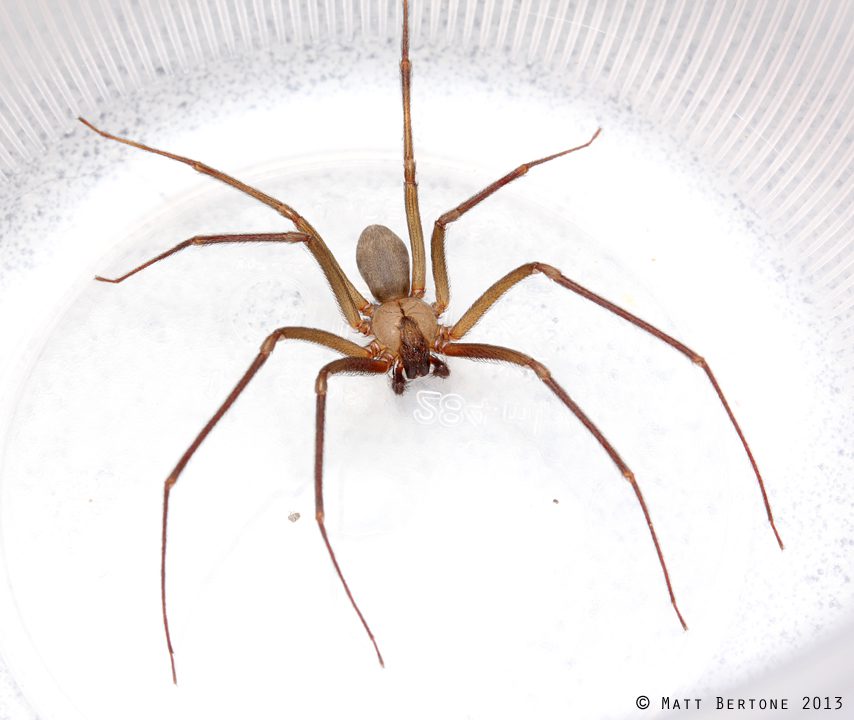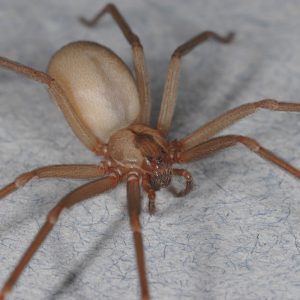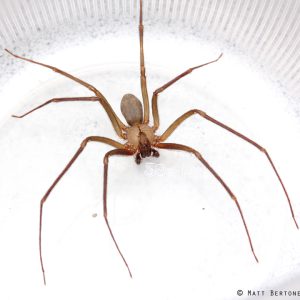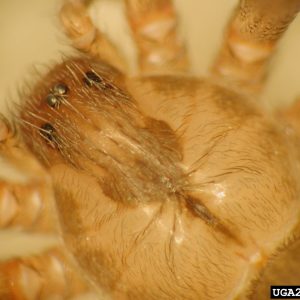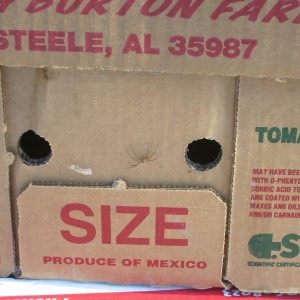Home

Learn how to keep this menacing and potentially harmful spider away from you and your family. Monitor favorite habitats around your home and know what to do if you are bitten.
People often fear spiders because of their ill-deserved reputation for poisoning victims. Most spiders do not have mouthparts strong enough to penetrate the skin. Spiders are considered beneficial arthropods because they often prey on insects and small soft-body arthropods that we consider nuisances. Homeowners should leave spiders alone if they are in their natural habitats, such as the yard or garden. However, the brown recluse, Loxosceles reclusa, is one of the exceptions.
Description
The brown recluse spider belongs to a group of spiders commonly known as the “fiddle-back” or “violin spider” because of the violin-shaped marking on the dorsal surface of the cephalothorax (fused head and thorax) with the neck of the violin pointing toward the abdomen (figure 1). The shape and intensity of the fiddle design may vary. A more definitive diagnostic feature is the eye pattern on the front of the cephalothorax—six eyes arranged in three pairs in a semicircle pattern with a space between each pair (figure 2). Most spiders have eight eyes.
The brown recluse spiders are pale tan to brown, with uniformly colored no-spine legs. Female bodies range in size from 10 to 15 millimeters (about 1⁄4 to 1⁄2 inch) and have a leg span over 25 millimeters (1 inch). Males are generally half the size of females. They molt a shed skin stretching out on a flat surface (figure 3).
Some brown-colored spiders are often mistaken for brown recluses. Eye patterns can differentiate them. The sac spiders and funnel weaver (hobo) spiders have eight eyes arranged in two rows of four, whereas the cellar spider species have either eight eyes closely grouped or six eyes grouped in two clusters.
- Figure 1a. Female brown recluse spider with a violin shape on the cephalothorax. (Photo credit: Richard Vetter and Matt Bertone, North Carolina State University)
- Figure 1b. Male brown recluse spider with a violin shape on the cephalothorax. (Photo credit: Richard Vetter and Matt Bertone, North Carolina State University)
- Brown recluse eye arrangement. (Photo credit: Lisa Ames)
- Figure 3. A brown recluse molt attached to the side of a stored box. (Photo credit: Amber C. Marable)
Distribution and Habitat
The brown recluse spider has been collected throughout Alabama but is more commonly found in the state’s northern half.
In nature, the brown recluse spider lives outdoors in dry areas such as caves and rock and log piles. Around homes, they are most likely encountered under woodpiles, overhangs, tree bark, wall voids, leaf litter, brush, and crawl spaces.
They are attracted to homes because there are hiding places and prey to eat. They get into homes through crevices or cracks in foundations or around doors, vents, or under eaves or soffits. People may even carry these spiders into residential buildings in boxes, furniture, and other items. They have adapted well to living indoors. In homes, they are found in areas without air conditioning or ventilation, such as near a furnace or water heater, in the bathroom behind a toilet or tub, and in the basement or under stairs. They are also found in cluttered storage areas and closets, under furniture and folded bedding, and in any other cluttered areas where it is dry and warm. They are also commonly found in storage boxes, shoes, coats, stored clothes, and drawers. They are active in temperatures between 45 degrees F and 110 degrees F. However, they may become inactive in winter as they respond to lower light cycles even in a heated home.
Habits and Behavior
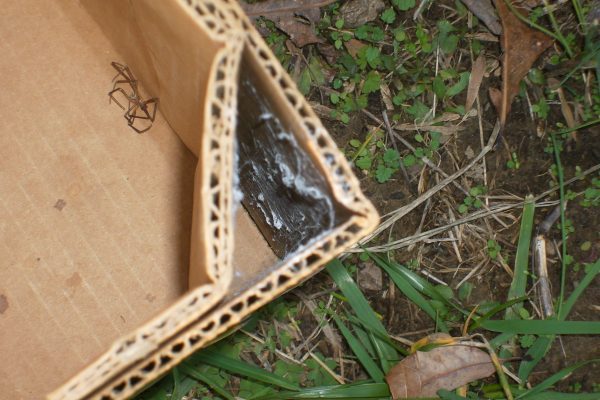
Figure 4. A good example of a brown recluse’s flat web in the corner of a stored box. Note the dead brown recluse inside the box. (Photo credit: Amber C. Marable)
Brown recluse earns its name for its shy nature. During the day, they rest in hidden locations in dark, secluded areas. At night, they wander out seeking prey. Occasionally, they may be seen wandering out of their retreat and crawling on floors, walls, and other exposed surfaces during daylight hours. This behavior is usually triggered by hunger, pesticide application, overcrowding, or disturbance.
Brown recluse spiders eat live and dead insects. They have remarkable survival skills and can go for up to 12 months without food or water and may live for up to 2 years.
Unlike most web weavers, brown recluse spiders do not construct webs to catch prey. Instead, they build irregular flat webs named “retreats” consisting of disorderly silk strands (figure 4). Females use silk retreats to form egg sacs. Females seldom venture far from their retreats, whereas males and older juveniles are more mobile and tend to travel farther.
When threatened, they usually flee, seemingly to avoid a conflict. They do not jump, and the young do not balloon; that is, they do not use silk strands to disperse in the wind as other young spiders do. Despite their reclusive habits and nonaggressive nature, they do occasionally bite people. Brown recluse spiders have tiny fangs and cannot bite through clothing. Humans are usually bitten when they inadvertently roll onto a spider during sleep, put on clothing or shoes, or move stored items containing spiders.
Brown recluse spiders are solitary. But in case of heavy infestation, it is possible to find large numbers of them in a small area.
Life Cycle
Brown recluse spiders are long-lived. They mature in about a year and have an average life-span of 2 to 4 years.
Female lays about forty to fifty tiny yellow eggs inside a sticky silken sac less than an inch in diameter. A female can produce several sacs and up to 300 eggs during the summer. The female spider will guard the egg sac until the spiderlings emerge.
The eggs hatch in about one month. The spiderlings molt five to eight times between 10 and 12 months to develop into adults. This spider is resilient and can tolerate up to 6 months of extreme drought or absence of food.
The Bite and Medical Significance
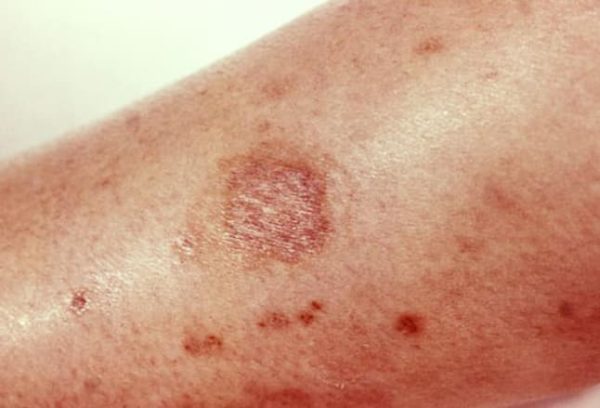
Figure 5. Brown recluse bite. (Photo credit: Centers for Disease Control and Prevention).
Spider bites, in general, are a rare phenomenon. A spider typically bites out of self-defense, and the brown recluse is no exception.
Spider bites are difficult to diagnose, even by physicians. Often, the initial bite is not painful, but the venom is a potent cytotoxin that may cause an enlarging necrotic sore that has difficulty healing. Most brown recluse spider bites remain localized, healing within 3 weeks without serious complications or medical intervention. In some cases, the bite produces a necrotic lesion, typically resulting in a flat or slightly sunken bluish patch with irregular edges, a pale center, and peripheral redness, often with a central blister (figure 5). The ulcerated and sunken wound may expand and take months to heal.
In rare instances, bites in the early stages induce systemic reactions accompanied by fever, dizziness, chest pain, nausea, or vomiting, particularly in children and older adults. Death is extremely rare.
First aid for someone who has been bitten by a brown recluse spider includes the use of an ice pack to prevent or reduce the swelling in the area where the bite occurred. Cooling the area helps to lessen tissue damage and reduce burning sensation, pain, and swelling. Clean the wound using mild soap and water, and apply an antibiotic ointment to prevent infection.
Victims should promptly seek medical treatment from licensed doctors. If the spider can be found and identified as the likely culprit, it should be taken with the patient to the doctor. Even crushed or damaged specimens can usually be identified. Confirmation by an expert will help the physician decide on the appropriate course of treatment.
Controlling Infestations
Once established in a home, brown recluse spiders are often difficult to control. They can take shelter in dry, dark, undisturbed areas, and many such places exist inside homes and buildings. Because of their secretive habits and potential health threats, treatment is best performed by a professional pest control service.
Successful brown recluse control requires an integrated pest management (IPM) plan that uses several control methods and involves cooperation between residents or homeowners and pest management professionals (PMP).
Residents should take steps to prevent bringing pests home and keep homes clean and clutter free. Call professionals when pests occur, and prepare the dwelling so PMPs can access potential spider hiding sites for inspection and treatment. Until the brown recluse is completely controlled in a home, residents should carefully check and shake out their bedding before going to sleep. Remove bed skirts to reduce the chances of spiders crawling onto the bed. Brown recluse spiders usually hide during the day and come out at night. These spiders often bite if they are trapped against skin.
The PMP’s role includes conducting a thorough inspection, deciding on control technology and products, and practicing the treatment.
Sanitation and Prepare for Inspection
Exercise caution in places you do not frequently visit, such as a storage shed, cellar, and deep recesses of the garage and basement.
Eliminate spider harborages by decluttering closets and storage rooms and areas. Eliminate spider food sources by cleaning off dead and alive insects.
If a professional service is used, remove clutter to give the PMP access for inspection to places where the brown recluse spiders may hide. This includes behind furniture; inside closets and rooms with boxes and stored items such as books and toys; utility rooms; boxes; fireplace; attic; basement; crawl space, etc.
Inspection
A thorough inspection with a bright flashlight to reveal the location and level of infestation is the first step in effective management. Inspection should focus on likely spider habitats. Indoors, look for spiders, egg sacs, and shed spider skins in undisturbed storage areas such as closets, crevices behind furniture and bed, behind hanging pictures, clothing, shoes, and especially storage containers and boxes. In an infested garage, attic, basement, or crawl space, search for signs along joists, sills, rafters, behind baseboards and woodwork, within ducts and registers, above suspended ceilings, and under rolled insulation. Brown recluse spiders may also inhabit the voids in the concrete block foundation and behind walls.
The person conducting the inspection should wear personal protective clothing such as gloves. Tape pant legs to shoes and shirt cuffs to gloves. To prevent spiders from crawling up pant legs, constrict the pants with rubber bands around the ankles. The person may even consider wearing a bee veil when inspecting severely infested homes to avoid bites.
Monitoring
Sticky spider traps and flat glue boards are excellent nonchemical ways to aid visual inspection. Besides being useful for detection, they can also catch and kill spiders, most likely the males and old juveniles. Position the traps in places where the spider is most likely to hide and forage. Such areas include the corner of the closet; along the baseboard and wall-floor junctures; behind furniture, clutter, and toilet; under sinks; on shelves; and near stored items because spiders tend to travel in these areas.
Professional pest control services can also use flushing agents as a monitoring tool to locate breeding areas. Remove any spiders and webs found by vacuuming so you can monitor potential spider activity in future inspections. Dispose of the bag outside.
Exclusion
Exclusion is to deny the spiders access to homes and hiding places. Seal cracks and crevices in the structure where spiders may gain access to the house. Common areas for cracks and crevices are windowsills, door thresholds, and around pipes and vents. Improve ventilation in attics and crawl spaces. Outdoors, eliminate potential breeding habitats such as woodpiles, leaf litter, and rocks where spiders may live near your house.
Chemicals
Pesticides labeled for spider control are often required for serious brown recluse infestations. Enlisting the services of a professional pest control operator is an option to be seriously considered when chemicals are to be applied. Target applications on exterior and interior cracks and voids where the spiders are known or suspected to be feeding or hiding. Encapsulated formulations of residual pesticides and waterproof dust are good choices for spot treating spaces such as wall voids, cracks, crevices, behind shutters, baseboards, outlet covers, and under siding. Aerosol products can be sprayed directly on the spiders. All the chemicals kill spiders by direct contact. Applications must follow label instructions to minimize the risks and maximize the benefits. Most importantly, pesticides are essential in conjunction with nonchemical measures such as vacuuming, sanitation, and harborage removal.
 Xing Ping Hu, Extension Specialist, Professor, Entomology and Plant Pathology, Auburn University.
Xing Ping Hu, Extension Specialist, Professor, Entomology and Plant Pathology, Auburn University.
Revised June 2022, The Brown Recluse Spider: Facts & Control, ANR-1043

